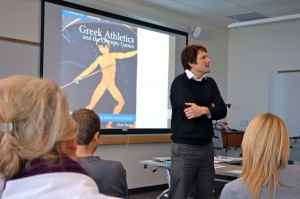“How many of you compete in sports in the nude?” questioned Eric Dugdale as he enthusiastically taught our class this morning. Eric Dugdale, an editor of Greek Athletics in the Olympics by Alan Beale, was referencing to a very odd phenomenon that existed in the Ancient Olympics. Although this seems somewhat barbaric today, the ancient Greeks viewed this as a way to display and honor the bodies of the Olympic athletes.
Today, January 8th, Eric Dugdale came to our class as a guest speaker come in to discuss Sport in Antiquity. In order to prepare for his presentation, we were required to polish up our knowledge on the Ancient games and some of their legends, such as Milo of Croton, Ikkos of Tarentum, and a few others. Eric’s presentation focused more on the influence that athletics left on the Greek culture. In the ancient times the role of sports and athletics was for far more practical purposes than it is in modern day. Sports were in large part used as a way to prepare warriors for the battles between the Greek city-states.
During his presentation, Eric Dugdale cited eight sources of evidence for the ancient games: literary evidence, vase paintings, sculptures, victory monuments, inscriptions, papyri, coins, and archaeological sites. By using these sources, we have been able to obtain a better understanding of the Olympic events and their competitors.
All in all, Prof Dugdale’s presentation was extremely enlightening and informative. He obviously knows his stuff when it comes to Ancient Greek history. If you happen to run across this blog Prof Dugdale, thank you very much for sharing your time and knowledge with our class!!!
Jamie, Jered, and Greg
